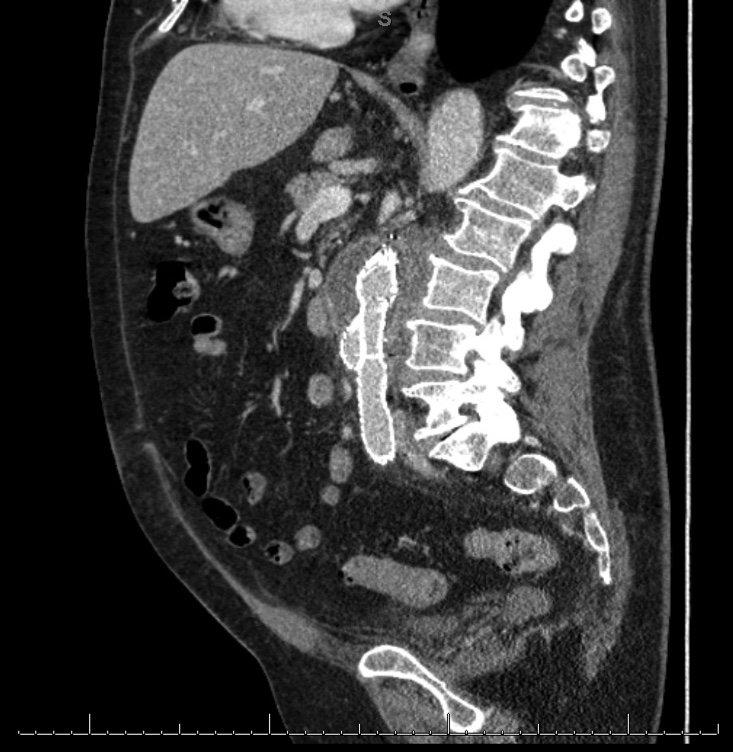Case Presentation: A 70-year-old male with a medical history significant for transurethral resection of bladder tumor and lung adenocarcinoma presented with diaphoresis and subjective fever 4 days after undergoing an uncomplicated aortic extension cuff placement for an abdominal aortic aneurysm. The patient was hemodynamically stable. Labs notable for leukocytosis of 18.4X10E9 cells/liter. CT abdomen demonstrated inflammation and fat stranding around the excluded aneurysmal sac and no additional endoleak. With concern for postoperative infection, empiric Vancomycin and Piperacillin/Tazobactam was initiated. The next day, fever of 38.3C and multiple episodes of diarrhea developed. Stool CD toxin returned negative. On Day 5, antibiotics were stopped due to suspicion for antibiotic-associated diarrhea. Diarrhea improved but leukocytosis worsened to 38.7X10E9 cells/liter. Multiorgan failure ensued with unstable hemodynamics requiring intubation and transfer to the Intensive Care. Antibiotics were changed multiple times with no improvement in clinical condition. On Day 26, blood cultures from Day 22 were identified as CD by RapID ANA II System. Antibiotics were changed to IV metronidazole to cover CD bacteremia and meropenem IV for the non-perfringens Clostridium bacteremia found on cultures from Day 8. Both isolates were identified concurrently as CD by matrix-assisted laser desorption/ionization time-of-flight mass spectrometer (MALDI-TOF). At this point, antibiotics were changed to vancomycin IV. Repeat stool CD toxin was negative. On Day 32 the patient passed after developing metabolic lactic acidosis and worsening hypotension. Source control was unable to be achieved due to the patient being a poor surgical candidate.
Discussion: According to the Centers for Disease Control (CDC), approximately 500,000 people acquire infection from Clostridium difficile (CD), resulting in approximately 15,000 deaths. Rarely does CD present as an extraintestinal manifestation [1]. To date, ~140 cases of CD bacteremia have been reported [1-5]. The patient had a persistent CD bacteremia but stool toxin was negative complicating the course. MALDI-TOF confirmed CD. Two blood culture isolates were indistinguishable by whole genome sequencing, were toxigenic and belonged to multi-locus sequence type (ST) 42, a fairly common hospital-associated lineage also known as ribotype 106. The primary source of infection was unclear but we can theorize that the intravascular device from the initial surgical procedure was the source. Various treatment combinations have been attempted for CD bacteremia with variable results [3-5]. Review of literature demonstrated a case report that successfully treated CD bacteremia with surgical intervention and long-term antibiotics [2]. Source control was not achieved in this case due to the patient being a poor surgical candidate. CD bacteremia remains a disease of poor prognosis with a mortality rate of 35% [5].
Conclusions: We present a rare case of CD bacteremia with no symptoms of colitis and a negative stool toxin in a patient with prior Endovascular Aortic Aneurysm Repair. In addition to antibiotic therapy, management of CD bacteremia requires identification of the source of infection and resolution of infection at the source. The treatment of CD bacteremia is increasingly complicated by the occurrence of multidrug-resistant strains. There is no direct data demonstrating benefit of combination therapy in CD bacteremia and further work is needed in this field.

